Abstract
Pretreatment of mice by intravenous injection with killed Listeria provided neither delayed-type hypersensitivity to Listeria protoplasm nor protection against Listeria infection. Assuming that this suppression is due to suppressor cells, we attempted to clarify their induction and characterization. Pretreatment with killed BCG instead of killed Listeria suppressed the induction of DTH and protection in subsequent Listeria-immunized mice. Conversely, pretreatment with killed Listeria suppressed subsequent induction of DTH to PPD or protection from tuberculosis. Thus, these suppressions were induced antigen nonspecifically. Transfer of splenic non-adherent cells from killed Listeria-injected mice which had been treated with anti-BA theta serum plus complement, or had been passed through Sephadex G-10 columns, resulted in both afferent and efferent DTH suppression, suggesting that the DTH suppression is closely associated with suppressor T cells. Moreover, the splenic nonadherent cells from killed Listeria-injected mice showed suppression in vitro of listericidal activity of PEC from Listeria-immune mice in the presence of Listeria protoplasm.
Full text
PDF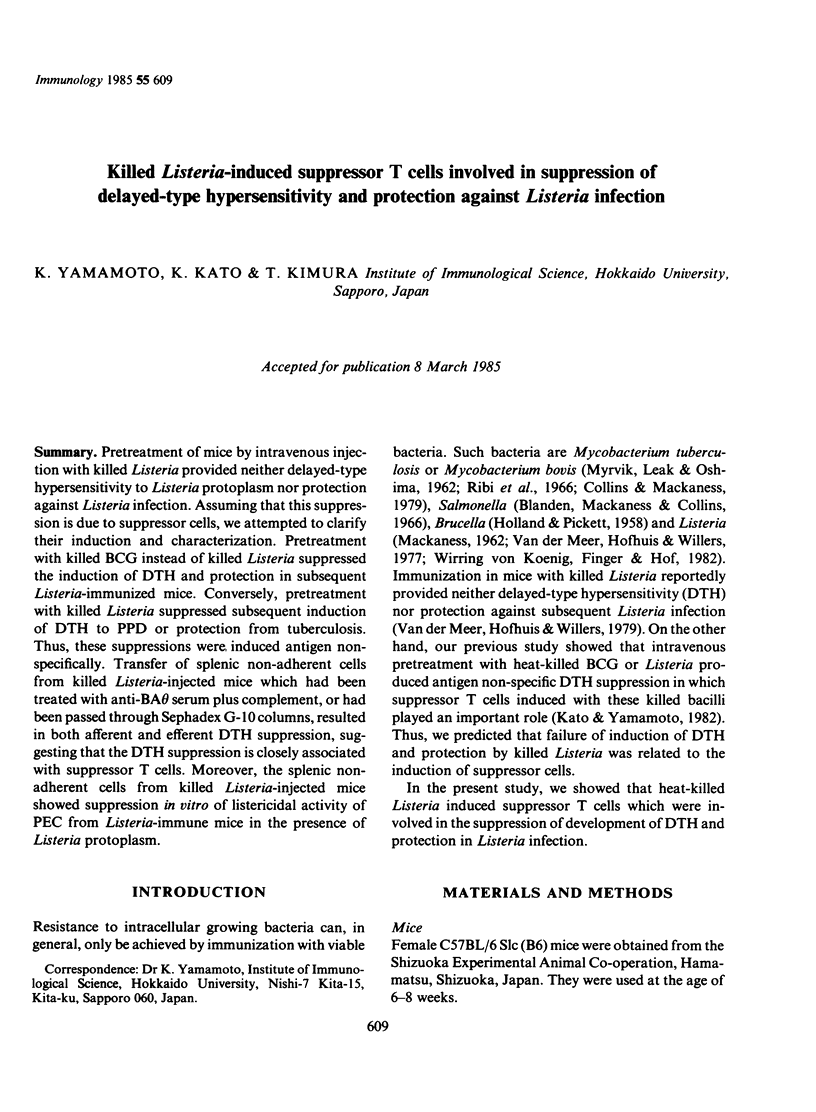

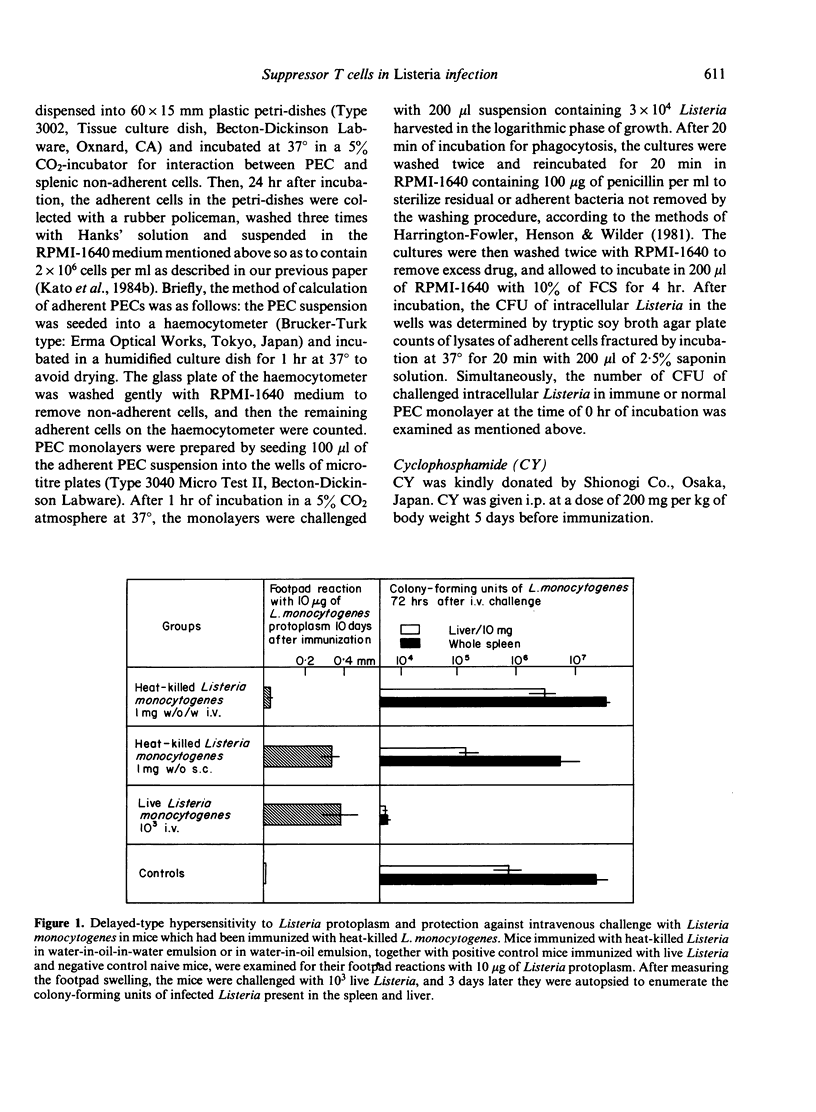
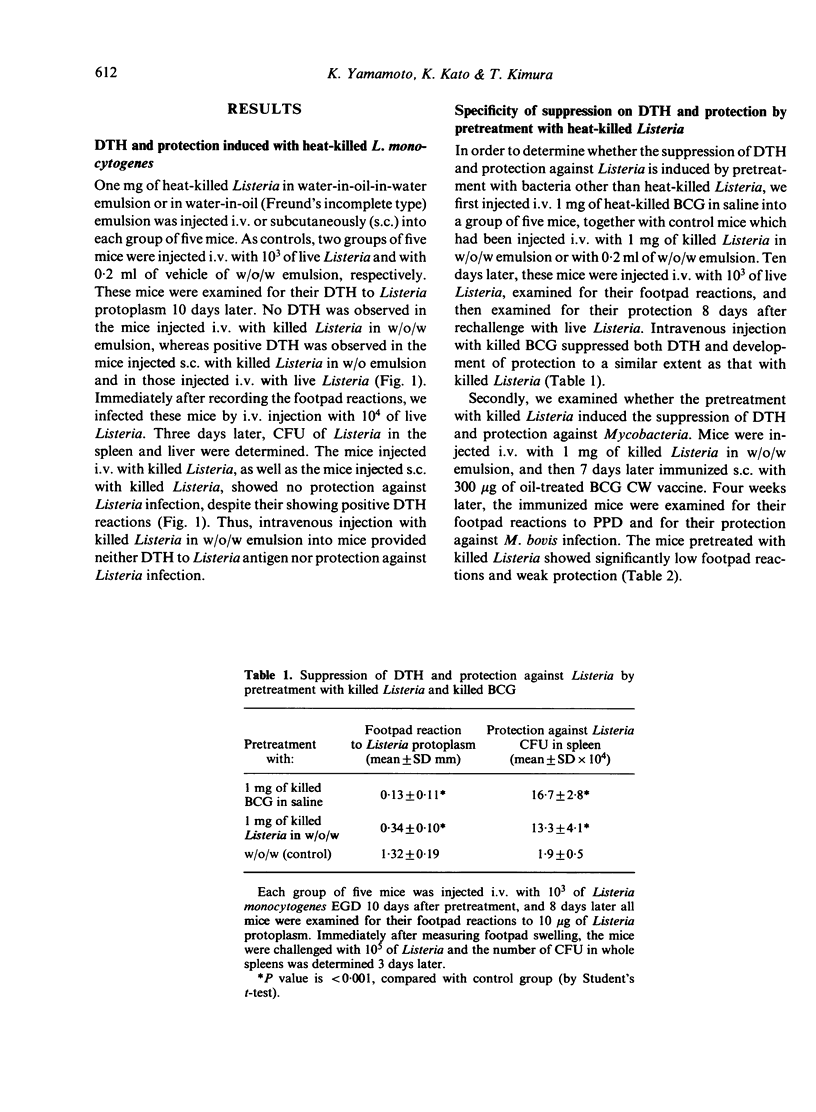


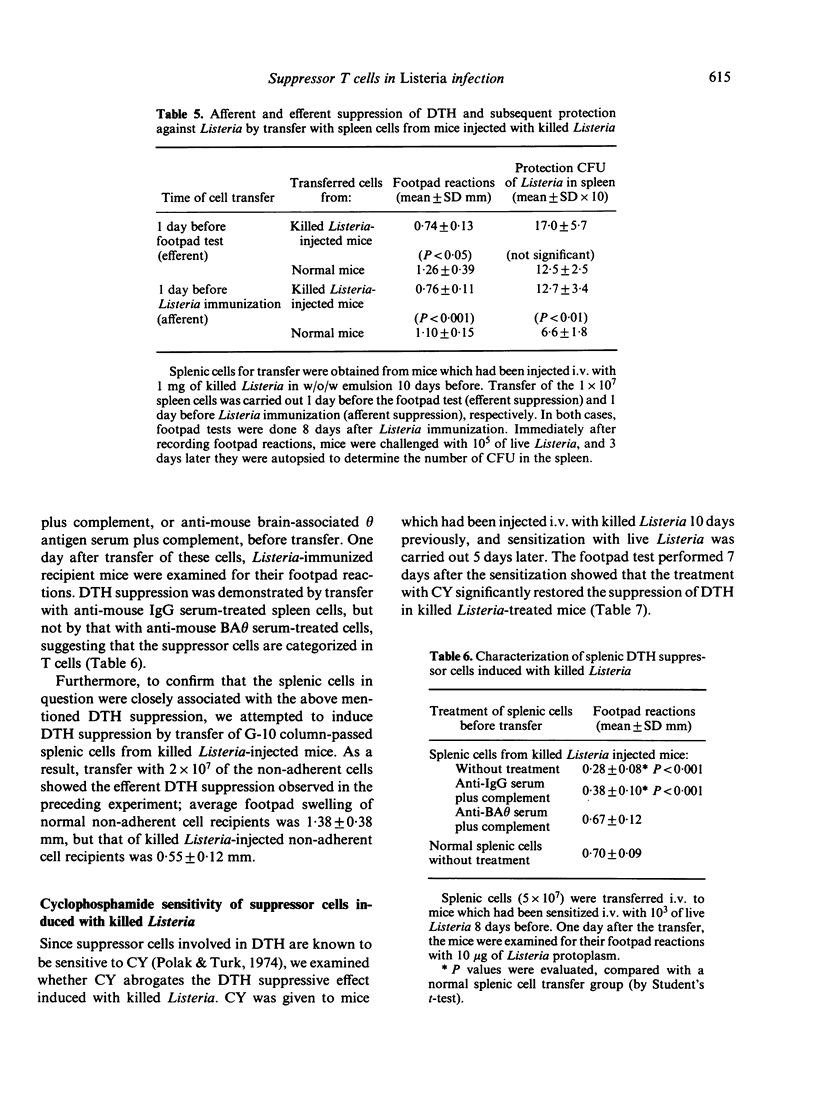
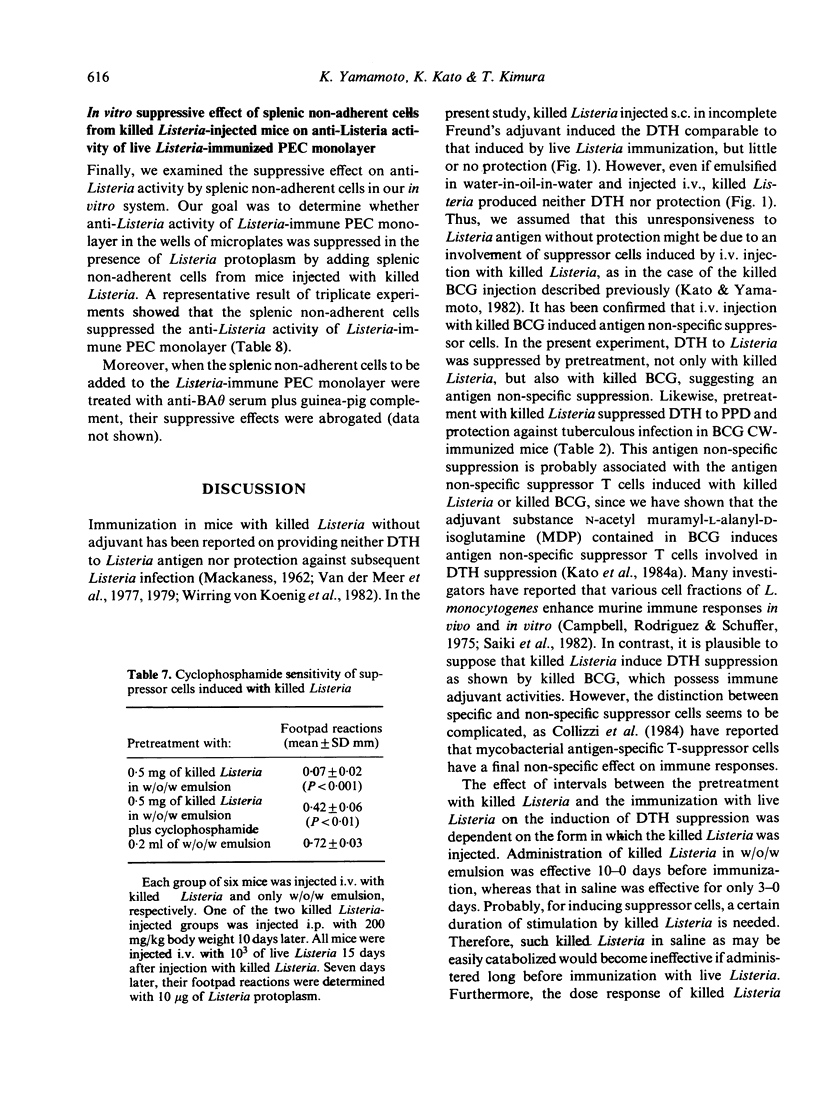



Selected References
These references are in PubMed. This may not be the complete list of references from this article.
- Bach B. A., Sherman L., Benacerraf B., Greene M. I. Mechanisms of regulation of cell-mediated immunity. II. Induction and suppression of delayed-type hypersensitivity to azobenzenearsonate-coupled syngeneic cells. J Immunol. 1978 Oct;121(4):1460–1468. [PubMed] [Google Scholar]
- Blanden R. V., Mackaness G. B., Collins F. M. Mechanisms of acquired resistance in mouse typhoid. J Exp Med. 1966 Oct 1;124(4):585–600. doi: 10.1084/jem.124.4.585. [DOI] [PMC free article] [PubMed] [Google Scholar]
- Campbell P. A., Rodriguez G. E., Schuffler C. Listeria cell wall fraction: adjuvant activity in vivo and in vitro. Cell Immunol. 1975 Jun;17(2):418–422. doi: 10.1016/s0008-8749(75)80045-1. [DOI] [PubMed] [Google Scholar]
- Collins F. M., Mackaness G. B. The relationship of delayed hypersensitivity to acquired antituberculous immunity. II. Effect of adjuvant on the allergenicity and immunogenicity of heat-killed tubercle bacilli. Cell Immunol. 1970 Sep;1(3):266–275. doi: 10.1016/0008-8749(70)90048-1. [DOI] [PubMed] [Google Scholar]
- Dwyer J. M., Parker D., Turk J. L. Suppression of delayed hypersensitivity to tuberculin by antigenic competition. A positive immunoregulatory mechanism sensitive to cyclophosphamide. Immunology. 1981 Apr;42(4):549–559. [PMC free article] [PubMed] [Google Scholar]
- Gasbarre L. C., Hug K., Louis J. Murine T lymphocyte specificity for African trypanosomes. II. Suppression of the T lymphocyte proliferative response to Trypanosoma brucei by systemic trypanosome infection. Clin Exp Immunol. 1981 Jul;45(1):165–172. [PMC free article] [PubMed] [Google Scholar]
- HOLLAND J. J., PICKETT M. J. A cellular basis of immunity in experimental Brucella infection. J Exp Med. 1958 Sep 1;108(3):343–360. doi: 10.1084/jem.108.3.343. [DOI] [PMC free article] [PubMed] [Google Scholar]
- Harrington-Fowler L., Henson P. M., Wilder M. S. Fate of Listeria monocytogenes in resident and activated macrophages. Infect Immun. 1981 Jul;33(1):11–16. doi: 10.1128/iai.33.1.11-16.1981. [DOI] [PMC free article] [PubMed] [Google Scholar]
- Kato K., Yamamoto K. I., Kakinuma M., Ishihara C., Azuma I. Suppression of BCG cell wall induced delayed-type hypersensitivity by BCG pre-treatment. I. Induction of adherent suppressor cells by live BCG injection and their characterization. Immunology. 1981 Feb;42(2):259–266. [PMC free article] [PubMed] [Google Scholar]
- Kato K., Yamamoto K., Kimura T., Azuma I., Askenase P. W. Suppression of BCG cell wall-induced delayed-type hypersensitivity by pretreatment with killed BCG: induction of nonspecific suppressor T cells by the adjuvant portion (MDP) and of specific suppressor T cells by the antigen portion (TAP). J Immunol. 1984 Jun;132(6):2790–2795. [PubMed] [Google Scholar]
- Kato K., Yamamoto K., Okuyama H., Kimura T. Microbicidal activity and morphological characteristics of lung macrophages in Mycobacterium bovis BCG cell wall-induced lung granuloma in mice. Infect Immun. 1984 Aug;45(2):325–331. doi: 10.1128/iai.45.2.325-331.1984. [DOI] [PMC free article] [PubMed] [Google Scholar]
- MACKANESS G. B. Cellular resistance to infection. J Exp Med. 1962 Sep 1;116:381–406. doi: 10.1084/jem.116.3.381. [DOI] [PMC free article] [PubMed] [Google Scholar]
- MYRVIK Q. N., LEAKE E. S., OSHIMA S. A study of macrophages and epitheloid-like cells from granulomatous (BCG-induced) lungs of rabbits. J Immunol. 1962 Nov;89:745–751. [PubMed] [Google Scholar]
- Miller S. D., Sy M. S., Claman H. N. The induction of hapten-specific T cell tolerance using hapten-modified lymphoid membranes. II. Relative roles of suppressor T cells and clone inhibition in the tolerant state. Eur J Immunol. 1977 Mar;7(3):165–170. doi: 10.1002/eji.1830070310. [DOI] [PubMed] [Google Scholar]
- Mitsuoka A., Morikawa S., Baba M., Harada T. Cyclophosphamide eliminates suppressor T cells in age-associated central regulation of delayed hypersensitivity in mice. J Exp Med. 1979 May 1;149(5):1018–1028. doi: 10.1084/jem.149.5.1018. [DOI] [PMC free article] [PubMed] [Google Scholar]
- Nakamura R. M., Tokunaga T. Induction of suppressor T cells in delayed-type hypersensitivity to Mycobacterium bovis BCG in low-responder mice. Infect Immun. 1980 May;28(2):331–335. doi: 10.1128/iai.28.2.331-335.1980. [DOI] [PMC free article] [PubMed] [Google Scholar]
- Phanupak P., Moorhead J. W., Claman H. N. Tolerance and contact sensitivity to DNFB in mice. 3. Transfer of tolerance with "suppressor T cells". J Immunol. 1974 Oct;113(4):1230–1236. [PubMed] [Google Scholar]
- Polak L., Turk J. L. Reversal of immunological tolerance by cyclophosphamide through inhibition of suppressor cell activity. Nature. 1974 Jun 14;249(458):654–656. doi: 10.1038/249654a0. [DOI] [PubMed] [Google Scholar]
- Ramos C., Schädtler-Siwon I., Ortiz-Ortiz L. Suppressor cells present in the spleens of Trypanosoma cruzi-infected mice. J Immunol. 1979 Apr;122(4):1243–1247. [PubMed] [Google Scholar]
- Ribi E., Larson C., Wicht W., List R., Goode G. Effective nonliving vaccine against experimental tuberculosis in mice. J Bacteriol. 1966 Mar;91(3):975–983. doi: 10.1128/jb.91.3.975-983.1966. [DOI] [PMC free article] [PubMed] [Google Scholar]
- Saiki I., Kamisango K., Tanio Y., Okumura H., Yamamura Y., Azuma I. Adjuvant activity of purified peptidoglycan of Listeria monocytogenes in mice and guinea pigs. Infect Immun. 1982 Oct;38(1):58–65. doi: 10.1128/iai.38.1.58-65.1982. [DOI] [PMC free article] [PubMed] [Google Scholar]
- Swamy P. K., Dwyer J. M., Kantor F. S. Desensitization in mice: T-cell requirement for nonspecific suppression of delayed-type hypersensitivity. Cell Immunol. 1981 May 15;60(2):308–313. doi: 10.1016/0008-8749(81)90272-0. [DOI] [PubMed] [Google Scholar]
- Thomas W. R., Smith F. I., Walker I. D., Miller J. F. Contact sensitivity to azobenzenearsonate and its inhibition after interaction of sensitized cells with antigen-conjugated cells. J Exp Med. 1981 May 1;153(5):1124–1137. doi: 10.1084/jem.153.5.1124. [DOI] [PMC free article] [PubMed] [Google Scholar]
- Van Der Meer C., Hofhuis F. M., Willers J. M. Killed Listeria monocytogenes vaccine becomes protective on addition of polyanions. Nature. 1977 Oct 13;269(5629):594–595. doi: 10.1038/269594a0. [DOI] [PubMed] [Google Scholar]
- Watson S. R., Collins F. M. Development of suppressor T cells in mice heavily infected with mycobacteria. Immunology. 1980 Mar;39(3):367–373. [PMC free article] [PubMed] [Google Scholar]
- Yamamoto K., Kakinuma M., Kato K., Okuyama H., Azuma I. Relationship of anti-tuberculous protection to lung granuloma produced by intravenous injection of synthetic 6-O-mycoloyl-N-acetylmuramyl-L-alanyl-D-isoglutamine with or without specific antigens. Immunology. 1980 Aug;40(4):557–564. [PMC free article] [PubMed] [Google Scholar]
- Yamamoto K., Karinuma M. Genetic control of granuloma response to oil-associated BCG cell wall vaccine in mice. Microbiol Immunol. 1978;22(6):335–348. doi: 10.1111/j.1348-0421.1978.tb00378.x. [DOI] [PubMed] [Google Scholar]
- Zembala M., Asherson G. L. Depression of the T cell phenomenon of contact sensitivity by T cells from unresponsive mice. Nature. 1973 Jul 27;244(5413):227–228. doi: 10.1038/244227a0. [DOI] [PubMed] [Google Scholar]
- von Koenig C. H., Finger H., Hof H. Failure of killed Listeria monocytogenes vaccine to produce protective immunity. Nature. 1982 May 20;297(5863):233–234. doi: 10.1038/297233a0. [DOI] [PubMed] [Google Scholar]


